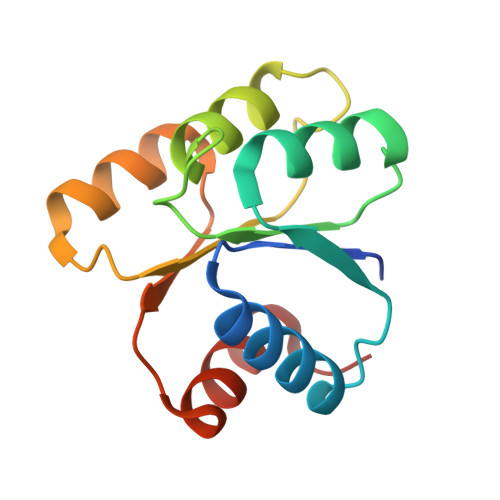Crystal structure of activated CheY1 from Helicobacter pylori.
Lam, K.H., Ling, T.K., Au, S.W.(2010) J Bacteriol 192: 2324-2334
- PubMed: 20207758
- DOI: https://doi.org/10.1128/JB.00603-09
- Primary Citation of Related Structures:
3GWG, 3H1E, 3H1F, 3H1G - PubMed Abstract:
Chemotaxis is an important virulence factor for Helicobacter pylori colonization and infection. The chemotactic system of H. pylori is marked by the presence of multiple response regulators: CheY1, one CheY-like-containing CheA protein (CheAY2), and three CheV proteins. Recent studies have demonstrated that these molecules play unique roles in the chemotactic signal transduction mechanisms of H. pylori. Here we report the crystal structures of BeF(3(-)-activated CheY1 from H. pylori resolved to 2.4 A. Structural comparison of CheY1 with active-site residues of BeF3(-)-bound CheY from Escherichia coli and fluorescence quenching experiments revealed the importance of Thr84 in the phosphotransfer reaction. Complementation assays using various nonchemotactic E. coli mutants and pull-down experiments demonstrated that CheY1 displays differential association with the flagellar motor in E. coli. The structural rearrangement of helix 5 and the C-terminal loop in CheY1 provide a different interaction surface for FliM. On the other hand, interaction of the CheA-P2 domain with CheY1, but not with CheY2/CheV proteins, underlines the preferential recognition of CheY1 by CheA in the phosphotransfer reaction. Our results provide the first structural insight into the features of the H. pylori chemotactic system as a model for Epsilonproteobacteria.
Organizational Affiliation:
Centre of Protein Science and Crystallography, Department of Biochemistry, Faculty of Science, The Chinese University of Hong Kong, Hong Kong.
















